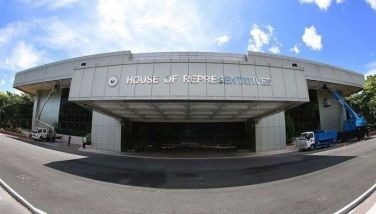Palace: No final decision yet on nuclear plant conversion
August 9, 2004 | 12:00am
Malacañang clarified yesterday there is no final decision yet on the proposal to convert the mothballed Bataan nuclear power plant (BNPP) in Morong, Bataan into a natural gas facility.
Deputy Presidential Spokesman Ricardo Saludo said the proposed conversion is not yet a done deal since the Department of Energy (DOE) is still conducting a study on how to convert the BNPP into a gas-fired power plant.
"They (DOE officials) will come out with a recommendation if they think that this (BNPP) can be utilized," he said.
Saludo stressed there is no final decision on the issue even as President Arroyo earlier announced plans to convert the 20-year-old nuclear facility into a natural gas-powered plant.
Mrs. Arroyo disclosed before a recent gathering of electricity cooperatives plans to convert the BNPP to head off a power crisis.
Mrs. Arroyo said the initiative would significantly reduce the country’s energy importation and put energy self-sufficiency up to 60 percent.
Starting next year, the government will be accepting offers from the private sector to convert the unused 620-megawatt BNPP, she said.
The $2-billion power plant, built in the early 1980s in a seismically active area, was found to have numerous defects and has never been used.
The proposal to revive the BNPP has been criticized by various sectors on fears that the conversion will cost the government more money than to build a new one.
Korea Electric Power Corp., which operates a 1,200-megawatt natural gas power plant and a 650-megawatt oil power station in the country, has estimated the conversion would cost around $600 million - and said it would be cheaper to build an entirely new power plant.
Mrs. Arroyo noted an Asian Development Bank study that indicated the Philippines needs to build 6,000 megawatts of additional power generation capacity over the next 10 years to avoid a repeat of a power shortage seen in the early 1990s.
The President said that would require an estimated P400 billion.
Administration Sen. Joker Arroyo said plans for the BNPP conversion have been "deceptively dangled" by energy officials to every elected president whenever there is a power crisis.
The senator branded the proposal as a "rehash" and "a diversionary move to distract the public from the problem only to be forgotten when the crisis is over."
Arroyo, executive secretary of former President Corazon Aquino who took over the government following the overthrow of strongman Ferdinand Marcos in 1986, said the BNPP is a monument of folly and corruption of the ousted regime.
He pointed out the BNPP was designed to operate a nuclear power reactor, an entirely different setup from fuel-fired power plants.
Opposition Sen. Alfredo Lim, for his part, said it would be better for the BNPP to be converted into a shopping center.
Lim suggested that the government should consider selling BNPP.
"If they cannot make a go of this nuclear facility in their original intention, then sell it off to the private sector and convert it into a shopping mall or whatever to make it productive instead of leaving it mothballed," Lim told reporters in mixed Filipino.
Lim expressed optimism that some private firms might get interested in buying the BNPP for commercial use.
He also believed that it would be cheaper for the government to construct a new power plant than to follow the proposal to convert BNPP into a gas-fired plant.
Saludo admitted the proposal was made as far back as the administration of former President Fidel Ramos which sought to use the idle facility for other purposes.
He said the ongoing DOE study will focus on how much will it cost to convert the BNPP. He added the DOE will also make recommendations over issues that may come up during the conversion.
"We have to look at the budget deficit. The conversion of this plant for example, would it entail huge additional expenses to our government?" he asked.
Saludo added the government has to address the outstanding debts in the construction of BNPP.
Industry sources alleged that the government is spending about $350,000 per day in interest payments for the loans used in the construction of the facility.
"The payments will continue," Saludo said. " We can’t turn our backs on this because the implications would be great." -With Evelyn Macairan
Deputy Presidential Spokesman Ricardo Saludo said the proposed conversion is not yet a done deal since the Department of Energy (DOE) is still conducting a study on how to convert the BNPP into a gas-fired power plant.
"They (DOE officials) will come out with a recommendation if they think that this (BNPP) can be utilized," he said.
Saludo stressed there is no final decision on the issue even as President Arroyo earlier announced plans to convert the 20-year-old nuclear facility into a natural gas-powered plant.
Mrs. Arroyo disclosed before a recent gathering of electricity cooperatives plans to convert the BNPP to head off a power crisis.
Mrs. Arroyo said the initiative would significantly reduce the country’s energy importation and put energy self-sufficiency up to 60 percent.
Starting next year, the government will be accepting offers from the private sector to convert the unused 620-megawatt BNPP, she said.
The $2-billion power plant, built in the early 1980s in a seismically active area, was found to have numerous defects and has never been used.
The proposal to revive the BNPP has been criticized by various sectors on fears that the conversion will cost the government more money than to build a new one.
Korea Electric Power Corp., which operates a 1,200-megawatt natural gas power plant and a 650-megawatt oil power station in the country, has estimated the conversion would cost around $600 million - and said it would be cheaper to build an entirely new power plant.
Mrs. Arroyo noted an Asian Development Bank study that indicated the Philippines needs to build 6,000 megawatts of additional power generation capacity over the next 10 years to avoid a repeat of a power shortage seen in the early 1990s.
The President said that would require an estimated P400 billion.
Administration Sen. Joker Arroyo said plans for the BNPP conversion have been "deceptively dangled" by energy officials to every elected president whenever there is a power crisis.
The senator branded the proposal as a "rehash" and "a diversionary move to distract the public from the problem only to be forgotten when the crisis is over."
Arroyo, executive secretary of former President Corazon Aquino who took over the government following the overthrow of strongman Ferdinand Marcos in 1986, said the BNPP is a monument of folly and corruption of the ousted regime.
He pointed out the BNPP was designed to operate a nuclear power reactor, an entirely different setup from fuel-fired power plants.
Opposition Sen. Alfredo Lim, for his part, said it would be better for the BNPP to be converted into a shopping center.
Lim suggested that the government should consider selling BNPP.
"If they cannot make a go of this nuclear facility in their original intention, then sell it off to the private sector and convert it into a shopping mall or whatever to make it productive instead of leaving it mothballed," Lim told reporters in mixed Filipino.
Lim expressed optimism that some private firms might get interested in buying the BNPP for commercial use.
He also believed that it would be cheaper for the government to construct a new power plant than to follow the proposal to convert BNPP into a gas-fired plant.
Saludo admitted the proposal was made as far back as the administration of former President Fidel Ramos which sought to use the idle facility for other purposes.
He said the ongoing DOE study will focus on how much will it cost to convert the BNPP. He added the DOE will also make recommendations over issues that may come up during the conversion.
"We have to look at the budget deficit. The conversion of this plant for example, would it entail huge additional expenses to our government?" he asked.
Saludo added the government has to address the outstanding debts in the construction of BNPP.
Industry sources alleged that the government is spending about $350,000 per day in interest payments for the loans used in the construction of the facility.
"The payments will continue," Saludo said. " We can’t turn our backs on this because the implications would be great." -With Evelyn Macairan
BrandSpace Articles
<
>
- Latest
- Trending
Trending
Latest
Trending
Latest
Recommended





























